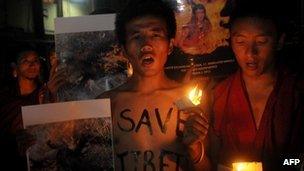Tibetan man 'sets himself alight' in north-west China
- Published

More than 50 ethnic Tibetans have set themselves on fire in protest at Chinese rule since 2009, activists say
A Tibetan man has died after setting himself alight at a Buddhist monastery in north-west China, rights campaigners have said.
The death is said to be the second self-immolation in the region in the last three days.
The London-based Free Tibet group said the man, identified as Dhondup, set fire to himself on Monday at Labrang Monastery in Gansu province.
The monastery is known for resistance to Chinese rule, the group says.
More than 50 ethnic Tibetans have set themselves on fire since such protests began in 2009 but this is the first self-immolation to take place in this monastery, it adds.
A spokesman for the Labrang monastery is reported as telling Agence France Presse that he was "uncertain" whether the incident had occurred.
Dhondup was described by campaigners as being in his 50s and married, with an adopted son.
Many of the earlier incidents of reported self-immolation have occurred in the western province of Sichuan.
However, Monday's incident follows another near the monastery on Saturday, when a man set himself alight after calling for the return of exiled spiritual leader the Dalai Lama, the Free Tibet group said.
Earlier this month, another Tibetan - 27 year-old Sangay Gyatso - also set himself on fire in the same region.
China's leaders blame the Dalai Lama, the Tibetans' exiled spiritual leader, for inciting the self-immolations and encouraging separatism.
He rejects this, and both activist groups and the Tibetan government-in-exile say the self-immolations are protests against tight Chinese control of the region and religious repression.
- Published13 October 2012
- Published14 August 2012
- Published8 August 2012
- Published21 June 2012
- Published31 May 2012
- Published18 April 2012
- Published28 March 2012
- Published17 March 2012